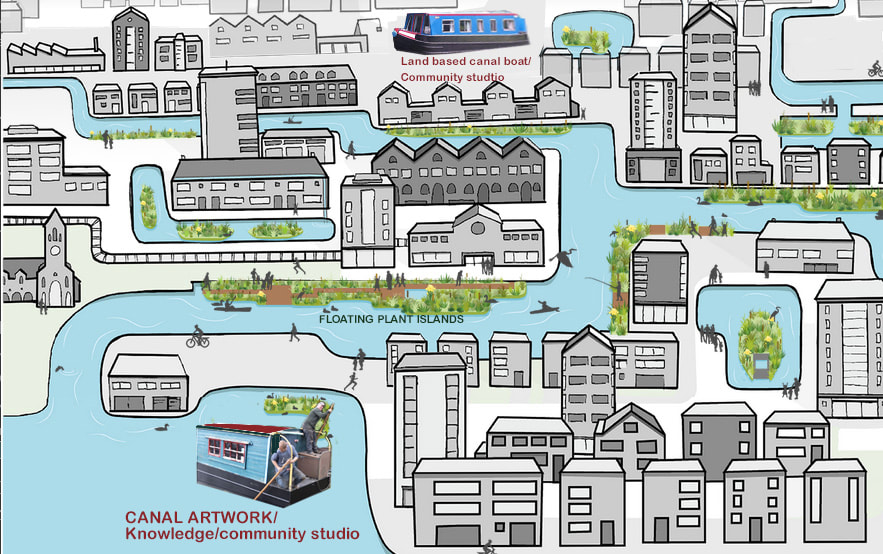About C.A.R.E
Climate Arts for Resilient environments was founded by Artist, SylvIa Grace Borda, & Health Innovator, Dr Ann Elizabeth Borda to activate people and spaces BY ADDING BIODIVERSITY and healthy enabling place-making TO URBAN AND RURAL SPACES
We believe strongly in guiding communities + organizations in creating a future that is healthy and inclusive for all.
We are a group of creatives, innovators, and health experts that love to help people meet their own needs to overcome challenges to create a culturally and ecologically rich environments for everyone.
We work with planners, architects, government, non-profits, to name a few. We believe in exploring and daring to lead the way to let people link up with communities to better understand the power of visual art, design ideas, and nature - that's our thing.
The structure of some of C.A.R.E’s larger scale urban redevelopment projects are often as follows:
1. A challenge is identified for a co-design solution – e.g. under-utilized land (brown/industrial sites) to be rehabilitated for healthy place-making
2. Exchanging ideas with stakeholders– e.g. the ways nature-enhancing artworks can function as elements within the environment - e.g. land is co-designed to become more ecologically diverse through native species plantings and place-making features
3. Designing complementary sustainable solutions – e.g. solar, wind, water harvesting technologies incorporated into the eco-artworks that act as educational sites to support public awareness and custodianship
4. Discussing prototypes through community and local engagement
5. Partnership-building through project development
Neighbourhood residents, stakeholders, designers, artists, companies, architects, landscape architects, university partners, urban planners, municipal government representatives, regional land bodies and garden groups contribute and add to the project’s development
6. Action and community processes - partners work towards implementation of eco-artworks
and development of healthy placemaking for public and biodiverse environments. Regional
groups maintain the site.
7. Public Launch - community use of land and eco-art interactions
8. Training and mentorship with communities, school educators, students, garden groups to
reinforce custodianship, public awareness and evolution of the place-making of the site.
9. Legacy building - creating tangible legacies where eco-artworks become a destination, and
intangible cultural heritage enhance a neighbourhood. The vision is for ecological
rehabilitation and regeneration to far exceed its initial investment and to create on-going
benefits for nature, resilience and the health of local communities.
OVERALL
C.A.R.E’s interdisciplinary approach aims to raise the level of innovation in ecological and healthy place-making development and in broadening public understanding of art, eco-sustainability, and custodianship.
We are a group of creatives, innovators, and health experts that love to help people meet their own needs to overcome challenges to create a culturally and ecologically rich environments for everyone.
We work with planners, architects, government, non-profits, to name a few. We believe in exploring and daring to lead the way to let people link up with communities to better understand the power of visual art, design ideas, and nature - that's our thing.
The structure of some of C.A.R.E’s larger scale urban redevelopment projects are often as follows:
1. A challenge is identified for a co-design solution – e.g. under-utilized land (brown/industrial sites) to be rehabilitated for healthy place-making
2. Exchanging ideas with stakeholders– e.g. the ways nature-enhancing artworks can function as elements within the environment - e.g. land is co-designed to become more ecologically diverse through native species plantings and place-making features
3. Designing complementary sustainable solutions – e.g. solar, wind, water harvesting technologies incorporated into the eco-artworks that act as educational sites to support public awareness and custodianship
4. Discussing prototypes through community and local engagement
5. Partnership-building through project development
Neighbourhood residents, stakeholders, designers, artists, companies, architects, landscape architects, university partners, urban planners, municipal government representatives, regional land bodies and garden groups contribute and add to the project’s development
6. Action and community processes - partners work towards implementation of eco-artworks
and development of healthy placemaking for public and biodiverse environments. Regional
groups maintain the site.
7. Public Launch - community use of land and eco-art interactions
8. Training and mentorship with communities, school educators, students, garden groups to
reinforce custodianship, public awareness and evolution of the place-making of the site.
9. Legacy building - creating tangible legacies where eco-artworks become a destination, and
intangible cultural heritage enhance a neighbourhood. The vision is for ecological
rehabilitation and regeneration to far exceed its initial investment and to create on-going
benefits for nature, resilience and the health of local communities.
OVERALL
C.A.R.E’s interdisciplinary approach aims to raise the level of innovation in ecological and healthy place-making development and in broadening public understanding of art, eco-sustainability, and custodianship.
A key ethos of C.A.R.E is to simultaneously enhance the environment, increase ecological
diversity, create healthy place-making, and provide a venue for learning— as a way to address impacts from climate change to sustainable development goals. By nature of C.A.R.E’s functional utility to increase biodiversity, resilience and health in urban landscapes - the artwork becomes an eco-activity across experts from architecture and urban design to mechanical engineering and environmental sciences, as well as educators and citizen groups.
diversity, create healthy place-making, and provide a venue for learning— as a way to address impacts from climate change to sustainable development goals. By nature of C.A.R.E’s functional utility to increase biodiversity, resilience and health in urban landscapes - the artwork becomes an eco-activity across experts from architecture and urban design to mechanical engineering and environmental sciences, as well as educators and citizen groups.
